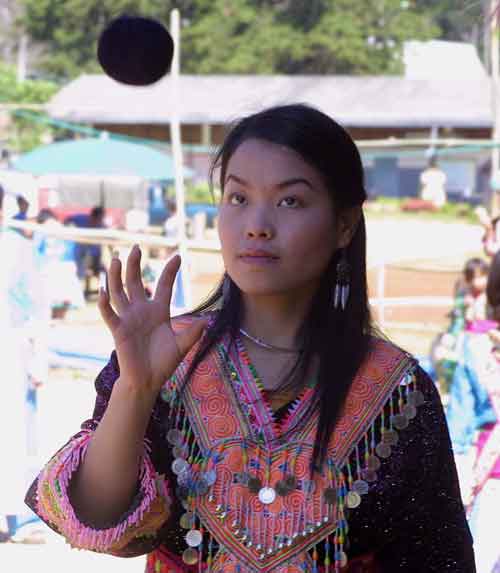|
sounds of Thailand
audio recordings that evoke the country, the people and their languages and the diversity of the music of the ethnic cultures
Hmong music |
|
|
sounds of Thailand
audio recordings that evoke the country, the people and their languages and the diversity of the music of the ethnic cultures
Hmong music |
|
| wedding music | played on reed pipes (qen) | 1.5MB | |
| song sung by young woman | the song is about going to lie with your new husband and missing your home and parents | 1.2MB | |
| brass mouth harp solo | courting music | 800KB | |
| reed pipe solo | the instrument has finger holes like a side flute but uses a brass reed to make the sound | 900KB | |
| bass reed pipe solo | recorded in Luang Prabang | 878KB | |
| duct flute solo | recorded on Doi Pui at the New Year festival | 665KB |
 |
There is a wide
variety of traditional Hmong vocal and instrumental genres for both
secular and ritual uses. The Hmong, however, are the only hill tribe
people not to have a tradition of choral singing. Instrumental music
is also always solo. Ritual music Shaman chants are heard at healing ceremonies, the New Year’s festival and life-cycle events. They are sung syllabically to melodies in which the eight speech tones are coordinated with four pitches. Typically, the shaman punctuates the chant with a sistrum and finger rattle while an assistant sounds a gong. The instrument most closely associated with Hmong ritual music is the reed pipes (qen), which is played at funerals, ancestral rites, offerings to the spirits, sacrifices to the drum and weddings. Secular music Secular music consists of love songs and songs expressing a love of nature or the family and homeland, loneliness and loss. A common theme is the song of a young girl who has gone to live with her new husband and misses her family. One common form of song is khootseea or 'sung poetry' which follows both musical and poetic conventions but also allows some scope for the singer to improvise. In fact, personal creativity is an essential part of the performance. Women in particular use this genre, either young girls before marriage or especially after the prohibition on singing after marriage is removed when they become widows. Word tones are transferred to a set of musical notes, but not entirely consistently; rhythm is also important. Each verse is marked at the end by a low falling syllable and there are occasional vocal glides and frequent long drawn out notes. The most important context for singing khootseea is during the courtship games of the New Year festival. Rows of unmarried boys and girls throw courtship balls while singing. Syllables may be delivered in either a legato or non legato style sometimes with wide intervals (especially fifths). Notes tend to be of equal duration. Scales may have 3,4,5 or more tones. Other types of song include a syllabic male-female song sung without lengthy notes, nuptial songs, didactic songs sung by the elderly and puzzle songs. The Hmong have a unique style of mouth harp playing (using a brass instrument) for courting and also commonly use single free reed pipes and end-blown flutes. |
| follow the links in the menu to listen to and read about music of the ethnic cultures |
Thailand's natural world, birds and other wildlife Thai music sounds of everyday Thai life
music of Thailand's ethnic cultures
----------------------------------------------------------------------------------------------
all sound files in compressed mp3 form click on track title to hear the recording
sound files are extracts from longer files in wav format